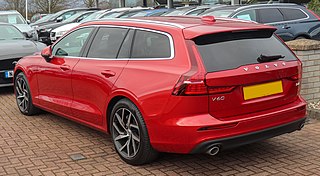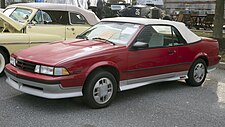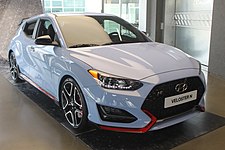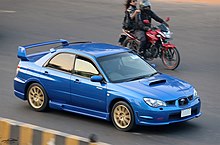
A sports car is a type of car that is designed with an emphasis on dynamic performance, such as handling, acceleration, top speed, the thrill of driving, and racing capability. Sports cars originated in Europe in the early 1910s and are currently produced by many manufacturers around the world.

A station wagon or estate car is an automotive body-style variant of a sedan with its roof extended rearward over a shared passenger/cargo volume with access at the back via a third or fifth door, instead of a trunk/boot lid. The body style transforms a standard three-box design into a two-box design—to include an A, B, and C-pillar, as well as a D-pillar. Station wagons can flexibly reconfigure their interior volume via fold-down rear seats to prioritize either passenger or cargo volume.

A hatchback is a car body configuration with a rear door that swings upward to provide access to the main interior of the car as a cargo area rather than just to a separated trunk. Hatchbacks may feature fold-down second-row seating, where the interior can be reconfigured to prioritize passenger or cargo volume.

A coupe or coupé is a passenger car with a sloping or truncated rear roofline and typically with two doors.

The Firenza is a model of car offered by Vauxhall from May 1971 until 1975. It was a development of the Viva, but had a distinctive coupé body style (fastback) and only two doors. In South Africa, it was sold as the Chevrolet Firenza until it was replaced by the Chevrolet 1300/1900 during 1975. Its name is derived from Firenze, the name of the Italian city known in English as Florence.

Plymouth was a brand of automobiles produced by Chrysler Corporation and its successor DaimlerChrysler. The brand was launched in 1928 to compete in what was then described as the "low-priced" market segment that was dominated by Chevrolet and Ford. It became a high-volume seller for the automaker until the late 1990s. Plymouth cars were marketed primarily in the United States. The brand was withdrawn from the marketplace in 2001. The Plymouth models that were produced up until then were either discontinued or rebranded as Chrysler or Dodge.

The Pontiac Sunbird is a model line that was manufactured and marketed by Pontiac from the 1976 to the 1994 model years. Loosely deriving its name from the Pontiac Firebird, the Sunbird was introduced as the eventual replacement for the Pontiac Astre, replacing it entirely in 1978 as the smallest Pontiac.

A hot hatch is a high-performance variant of a hatchback car. The term originated in the mid-1980s; however, faster factory versions of hatchbacks have been produced since the 1970s. A front-mounted engine that uses petrol for fuel, together with front-wheel drive, is the most common powertrain layout, however all-wheel drive has become more commonly used since around 2010. Most hot hatches are of European or Asian origin.
Governments and private organizations have developed car classification schemes that are used for various purposes including regulation, description, and categorization of cars.

The Renault Mégane, also spelled without the acute accent as Megane, especially in languages other than French, and also known as the Renault Megavan for an LCV in Ireland, as the Renault Scala in Iran and as the Renault Mégane Grandcoupé for the saloon in Israel, Palestinian Authority and Serbia for certain generations, is a small family car produced by the French car manufacturer Renault for the 1996 model year, and was the successor to the Renault 19. The Mégane has been offered in three- and five-door hatchback, saloon, coupé, convertible and estate bodystyles at various points in its lifetime, and having been through four generations is now in its fifth incarnation.

Pony car is an American car classification for affordable, compact, highly styled coupés or convertibles with a "sporty" or performance-oriented image. Common characteristics include rear-wheel drive, a long hood, a short decklid, a wide range of options to individualize each car and use of mass-produced parts shared with other models. The popularity of pony cars is largely due to the launch of the Ford Mustang in 1964.

The Chevrolet Cavalier is a line of compact cars produced by Chevrolet. Serving as the replacement of the Chevrolet Monza, the Cavalier was the second Chevrolet model line to adopt front-wheel drive. Three versions of the Cavalier have been sold, including three generations sold in North America from model years 1982 to 2005, a version produced by SAIC-GM for China from 2016 to 2021, and a SAIC-GM version produced for Mexico since the 2019 model year.

The Renault Alliance is a front-wheel drive, front-engine subcompact automobile manufactured and marketed in North America by American Motors Corporation (AMC) for model years 1983–1987. The Alliance and its subsequent hatchback variant, the Encore, were re-engineered Renault 9 & 11 for the U.S. and Canadian markets.

The Buick Skyhawk is an automobile produced by Buick in two generations for the 1975 through 1989 model years.

The Chevrolet Monza is a subcompact automobile produced by Chevrolet for the 1975 through 1980 model years. The Monza is based on the Chevrolet Vega, sharing its wheelbase, width, and standard inline-four engine. The car was designed to accommodate the GM-Wankel rotary engine, but due to mediocre fuel economy and emissions-compliance issues the engine was cancelled, and a V8 engine option was substituted. The Monza name has also been used for several other cars.

The Chevrolet Citation is a range of compact cars that was produced by Chevrolet from the 1980 to 1985 model years. The first front-wheel drive Chevrolet, the Citation replaced the Chevrolet Nova as the automaker downsized its compact cars. Initially slotted between the Chevrolet Monza and the Chevrolet Malibu in the Chevrolet product line, the model line was later marketed between the Chevrolet Cavalier and the Chevrolet Celebrity.

The Dodge Neon SRT-4 is a sport compact car manufactured by Dodge from 2003 to 2005. A turbocharged variant of the Neon, the car was developed by DaimlerChrysler's in house PVO tuner group. PVO was officially renamed SRT in 2004. The "4" in the SRT-4's name denotes the number of cylinders of the engine. ACR and Commemorative Edition models were later introduced as well.

The Chevrolet Chevy II/Nova is a small automobile manufactured by Chevrolet, and produced in five generations for the 1962 through 1979, and 1985 through 1988 model years. Built on the X-body platform, the Nova was the top selling model in the Chevy II lineup through 1968. The Chevy II nameplate was dropped after 1968, with Nova becoming the nameplate for all of the 1969 through 1979 models. It was replaced by the 1980 Chevrolet Citation introduced in the spring of 1979. The Nova nameplate returned in 1985, produced through 1988 as a S-car based, NUMMI manufactured, subcompact based on the front wheel drive, Japan home-based Toyota Sprinter.

A sports sedan is a subjective term for a sedan car that is designed to have sporting performance or handling characteristics.

Specialty Equipment Market Association (SEMA) of the automotive aftermarket was formed in 1963 by Paul Schiefer, Roy Richter, Ed Iskenderian, Els Lohn, Willie Garner, Bob Hedman, Robert E. Wyman, John Bartlett, Phil Weiand Jr, Al Segal, Dean Moon, and Vic Edelbrock Jr. Now it consists of 6,383 companies worldwide, bringing together aftermarket manufacturers, original equipment manufacturers (OEM), media, car dealers, specialty equipment distributors, installers, retailers, and restoration specialists.























